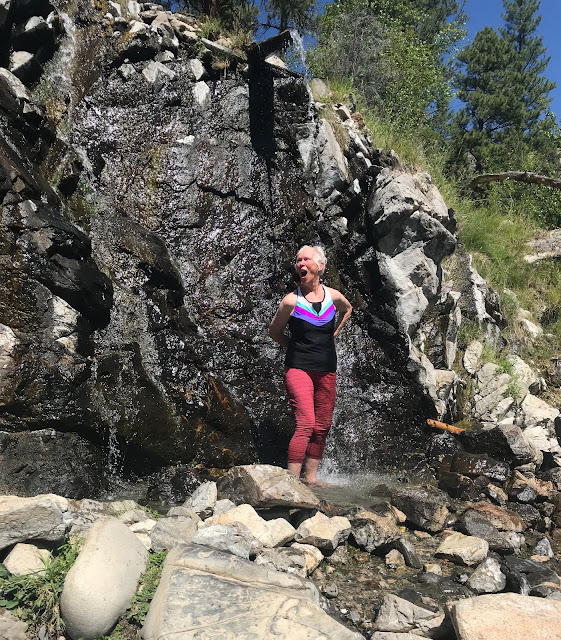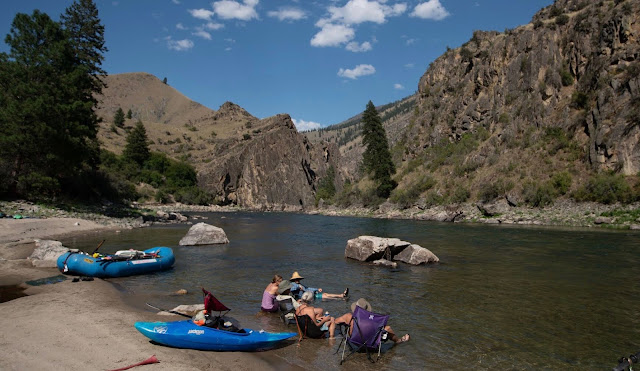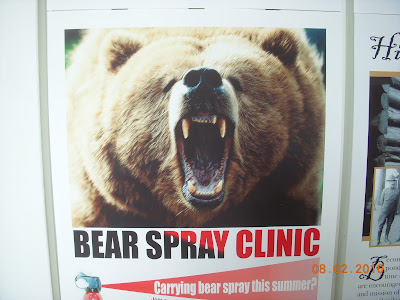 |
| Looking upstream from one of our camps on the Middle Fork of the Salmon River. |
Truth. I am a slow and deliberate writer and easily distracted. Also, I've been busy, occupied with extensive travels and interests. If I don't die first, I have a few dozen posts in the works.
More to the point, I couldn't figure out how to describe this trip without dissolving into maternal pride and boasting. Warning: there will be maternal pride and boasting.
I'll just get to it, finally, ...No more lame excuses.
About this time in 2018, PK and I along with six dear friends were feverishly prepping for a week-long adventure down the Middle Fork of the Salmon River, AKA River of No Return, in Idaho's Frank Church Wilderness.
We launched on July 12, 2018, with the masses.  It was a tense scene with commercial and private groups vying for position to descend the steep log slide to the river. It was a tense scene with commercial and private groups vying for position to descend the steep log slide to the river. Ferron Mayfield, in his elfin persona, blew bubbles as tempers roiled at the put-in. He soon joined the work crews. Having our son Chris join the trip at the VERY LAST MINUTE — like a half hour before we put on the river — was a momentous surprise. Without him, PK and I might still be stuck on rocks. And in my opinion, Chris' river and wilderness expertise and humble, gentle spirit enriched the experience for all. The Middle Fork of the Salmon is rated the best wilderness whitewater river trip in the West. If not in the entire USA. Maybe the world. The Universe? It deserves superlatives. It's a permit-only experience. Would-be floaters apply for limited permits in January and in February learn whether they won the lottery. PK and I have NEVER gotten a permit, but have been involved in several trips because we own a raft, camping gear, and possess rowing expertise. That would be Paul. With me in back-up position. Plus we are kinda fun people. And nice.  Twenty or so boats are ready to roll on down the river at the Boundary Creek put-in. Most are commercial outfitters. We will add our four private rafts and a kayak to the mix. The river's crystalline water, natural hot springs, dramatic gorges, sandy beach camps, and pristine cutthroat trout habitat combine to create a slam-bam-for-the-whole-damn-fam wilderness experience. The river is part of the 2.3 million-acre Frank Church Wilderness area.
Except for the Boundary Creek put-in and a few historic ranches downstream, the river corridor is without electronic connectivity or roads. Hallelujah!
The river descends 3000 feet in elevation through 100 miles of Class III-IV rapids and stunning scenery. It starts small - like a creek - through the alpine forest then gathers speed and power from tributaries before ripping through a rugged high desert to merge with the Main Salmon River.

Our group gathers to position one of our rafts for its launch down the steep log-slide to the river. Most of the weight is in the back.
Did I say steep? The camera angle distorts it,
but not by much. That's Ferron on the oars,
helping another group launch.
These boaters were with another private group.
The river level was on the edge of being too shallow for rafts. Rocks are sticking out all over the place, and dodging them with a fully loaded boat requires skill and luck.  Paul is an experienced whitewater rafter; this was his eighth time rowing the MFS, but luck was not with him. Like others in our group, we got stuck a few times. I took this photo from the front of our raft as Chris plunged over the slippery uneven river bottom to pull us free.  Jenna and Jerry Marmon, on their first trip down the MFS, encountered exposed rock as we did. Chris is waiting on river right, but intervention was not required.  Downriver, John Jessup rows and Gail Frank assists. Their roles reversed from time to time.  Ferron Mayfield and Sue Orris along with worried Curry enjoy rapid after rapid mile after mile.  Our first camp was idyllic. They all were. Campsites are reserved at the put-in with trip leaders negotiating for favorites sites. Reserved camping eases the pressure of getting down the river to score an extra special spot. Our first camp was idyllic. They all were. Campsites are reserved at the put-in with trip leaders negotiating for favorites sites. Reserved camping eases the pressure of getting down the river to score an extra special spot.  | |
Our hot spring camp the first night. Ahhhh! It's the Sheepeater Hotspring and is about a five-minute walk from camp. Paul Korbulic, John Jessup and Chris Korbulic.
Back at camp, Gail Frank, a fantastic cook who planned the menu for the entire trip, grills planked salmon over charcoal. Every single night was gourmet. We took turns cooking, and everyone pitched in on cleanup. As usual.
Had we launched a few days later, we may have
been forced to put in here, avoiding the by-
then impassable shallow rocky section we'd just scraped through. This launch area requires
flying in on bush planes. Expensive and scary!
flying in on bush planes. Expensive and scary!
Every camp was ideal, but I favored this one.
Paul enjoyed the fishing, catching about a dozen cutthroats
on dry flies during the trip.
on dry flies during the trip.
Gail worked hard and caught a nice fish. Catch and release, of course.
Cooking partners Jenna and Gail exult over a
sumptuous Dutch oven lasagne.
sumptuous Dutch oven lasagne.
Sue Orris basks in Sunflower hot spring overlooking the river. However, the four or five pools above the river are scorching. We all ended up in the "shower" at river level. Sunflower is the most popular of numerous hot springs along the river.
Chris Korbulic (AKA Charles Atlas) is in heaven with Sunflower hot springs massaging his shoulders. Ahhhh. We all had our turns.
That's me in my unfashionable outfit reacting to HOT.
Ferron and Paul enjoying a philosophical moment.
Casual relaxed interludes such as this rank high in defining private wilderness river trips.
Mornings are usually early with lots of coffee and a hearty breakfast. Packing and reloading rafts become the routine.
There she goes again! Beans, rice, and chicken
with all the Mexican condiments to accompany.
Gail is amazing. Want to hire her for a trip? Sorry,
she's busy building for Habitat for Humanity.
Perhaps you can tell that river trips, for me, are not as much about whitewater thrills as they are about the wilderness itself. After the put-in cluster, we saw few people but lots of wilderness wonders - and hours of in-the-water relaxing.
Jenna and Jerry prep their raft for another day on the river.
 Accustomed to sleeping on rocks and rough surfaces, Chris snoozes on a log. Sleeping like a log came to mind.
Accustomed to sleeping on rocks and rough surfaces, Chris snoozes on a log. Sleeping like a log came to mind.

Another hot spring, this one named Loon Creek for the snow-melt creek that runs alongside it. Where's Chris?
He's in the frigid snow-melt creek, more interested in cold therapy than hot. Curry is a fool for anybody who might toss water into his mouth. Life is strange. I kinda get it about the dog. But icy water with a natural hot spring nearby? No.

Later we stopped at one of the historic ranches, that now has a nifty convenience store with ice, beer, sunscreen, tee shirts, and toothbrushes. One of the horses along the trail appeared to be dining on tasty bird tidbits.

Chris relieved Paul at the oars when river action was quiet.
Sue and Ferron enjoy yet another tender moment.

Close to where the Middle Fork of the Salmon
merges with the Main Salmon, Paul checks his
watch. It is beer time? No. Because the gnarliest
rapid of the trip is coming right up on the Main
Salmon about a mile before takeout.
 Accustomed to sleeping on rocks and rough surfaces, Chris snoozes on a log. Sleeping like a log came to mind.
Accustomed to sleeping on rocks and rough surfaces, Chris snoozes on a log. Sleeping like a log came to mind.
Another hot spring, this one named Loon Creek for the snow-melt creek that runs alongside it. Where's Chris?

He's in the frigid snow-melt creek, more interested in cold therapy than hot. Curry is a fool for anybody who might toss water into his mouth. Life is strange. I kinda get it about the dog. But icy water with a natural hot spring nearby? No.

Later we stopped at one of the historic ranches, that now has a nifty convenience store with ice, beer, sunscreen, tee shirts, and toothbrushes. One of the horses along the trail appeared to be dining on tasty bird tidbits.

Chris relieved Paul at the oars when river action was quiet.
Sue and Ferron enjoy yet another tender moment.
 |
| Our final camp. Nobody is quite ready for the trip to end. |

Close to where the Middle Fork of the Salmon
merges with the Main Salmon, Paul checks his
watch. It is beer time? No. Because the gnarliest
rapid of the trip is coming right up on the Main
Salmon about a mile before takeout.
 |
| John Jessup flirts with a big flip hole while Gail contemplates her last will and testament. |
 |
Jenna makes it look ho-hum. In a few minutes, we'll be scrambling to take out just as we struggled to put in.
It's sad how the mood changes when you're in a big rush and other boaters are awaiting their turns. Then we're in our vehicles transitioning back home, to jobs, and for us lucky ones, on to further travels. The river experience recedes, but the glow lingers as we. prepare for the next chapter of the summer of 2018.
No one is traveling to a more exotic (or dangerous) place than Chris, and maybe no one appreciated this trip as much as he did. Although we all loved our time together.
Upon his return from Papua New Guinea, Chris posted this photo of Paul and me on Instagram and warmed our loving grateful hearts.
|





























